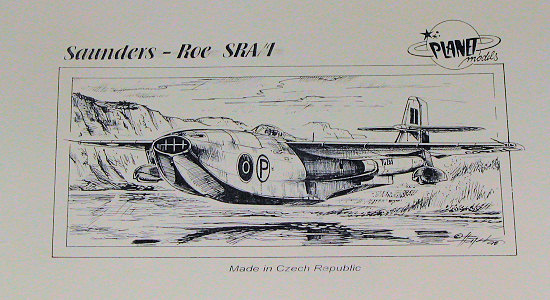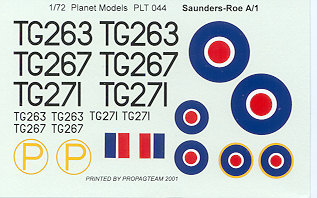
| KIT: | Planet Models 1/72 Saunders-Roe SRA/1 |
| KIT #: | 044 |
| PRICE: | $38.65 from www.greatmodels.com |
| DECALS: | Threee |
| REVIEWER: | Scott Van Aken |
| NOTES: | Resin with vacuformed canopy |

| HISTORY |
In 1943 two things were happening. First, turbojet propulsion was a reality and so designers were putting the new power plant to use in their designs. Secondly, the war in both Europe and the Pacific were at a turning point, but not at all certain. In the Pacific there was a real lack of aircraft carriers, and it was thought that the floatplane/flying boat were still a viable options.
Saro (Saunders-Roe) proposed the SR.44 a flying-boat fighter (inspired by the Japanese Nakajima A6M2-N"Rufe" and Kawanishi N1K1"Rex" floatplane fighters) which could be used in the Pacific. Seemed like a good idea at the time and in May 1944 a contract was awarded under specification E.6/44 for three prototypes.
Despite being put somewhat on the back burner, the SR.44, now called SR.A/1, took to the air on the 15/6/1947 some four years after it's proposal. This was shortly followed by the second and third aircraft. During four years of testing, the second and third prototype were lost in accidents. By all accounts, the aircraft was a delight to fly and thanks to its twin engines, had enough power to be useful. The rather tubby design also allowed for larger and more powerful engines to be installed should the aircraft be put into production. As neat as the design was, the reality was that there were more than enough aircraft carriers around, making the concept obsolete. The last flight of the prototype was in June of 1951, this aircraft being retired and it now resides in Duxford, England. It is not a small aircraft and when I saw it back in the late 1980s, I was quite taken with the size of it.
| THE KIT |
 I have always found Planet Models kits to be right up there among the better resin kits on the market. This is not exactly a new mold kit as the current kit numbers are near 200 and this one is #44. The molding is well done with finely engraved detail. Probably a bit too fine as I can see any sanding removing it. The kit also has very large sprue gates for the major assemblies, requiring some very intense and careful sanding to remove. For instance, in the image of the inside of the upper wings, those large lumps are the remnants of the resin pour gates that will need sanded down. They are about twice the thickness of the wing itself. The smaller bits are embedded into a resin wafer.
I have always found Planet Models kits to be right up there among the better resin kits on the market. This is not exactly a new mold kit as the current kit numbers are near 200 and this one is #44. The molding is well done with finely engraved detail. Probably a bit too fine as I can see any sanding removing it. The kit also has very large sprue gates for the major assemblies, requiring some very intense and careful sanding to remove. For instance, in the image of the inside of the upper wings, those large lumps are the remnants of the resin pour gates that will need sanded down. They are about twice the thickness of the wing itself. The smaller bits are embedded into a resin wafer.
A most basic cockpit is supplied with seat, stick and instrument panel to fit into a cockpit tub. Test fitting this tub shows that some adjustment will be needed to get a good fit. The kit is designed so that one can show the wing tip floats either retracted or extended. Though the kit does not show it as retracted, it seems to be easy enough. Since most modelers don't put their flying boats into a water setting, a set of beaching gear is supplied. A lone and very clear vacuformed canopy is provided.
Planet Models instructions of the time consist of a single exploded view on one side with the other containing a short history and a three view for decals and markings. This three view will come in quite handy as the exploded view leaves a bit to be desired in terms of exact placement of some of the parts, specifically the beaching gear. A Propagteam decal sheet provides markings for all three prototypes. The smaller roundels are all a bit off register as is one of the larger ones. A set of replacements would be recommended if your sheet is similar. To me, the reds and blues seem too bright anyway. All prototypes were unpainted metal without a nose anti-glare panel. There is also a set of grilles set back in the intake that the modeler will have to make from stretched sprue. It is not shown in the exploded view, but both the box art and markings guide show this.
| CONCLUSIONS |
This is just the sort of thing that I like. A prototype and something a bit off the wall as well. Thanks to its simplicity, it would be a great kit for a beginner to resin kits as there are no fussy parts, especially if the beaching gear are not installed. Even then, it will make a most unusual addition to any collection and just the sort of thing the 'what if' modelers revel in.
| REFERENCES |
The interweb
January 2007
You can find this and a whole lot more atGreatModels
If you would like your product reviewed fairly and quickly by asite that has nearly 350,000 visitors a month, please contactme or see other details in the